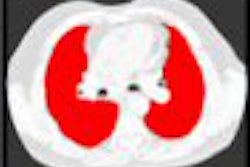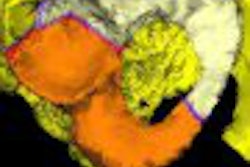SAN DIEGO - A growing body of research continues to advance the clinical and efficiency benefits of 3D ultrasound, but the technology may also offer a means of addressing the painful and costly issue of repetitive stress injuries in sonographers, according to a pair of studies presented at the recent 2008 American Institute of Ultrasound in Medicine (AIUM) meeting.
"Knowing that 20% of sonographers have career-ending repetitive stress injuries, 3D reconstructing also gives longtime employees an ergonomic alternative to scanning in pain," said Dr. Jennifer McDowell of Massachusetts General Hospital (MGH) in Boston.
At the meeting, McDowell presented two studies examining the impact of 3D on repetitive stress injuries. In the first study, the MGH researchers sought to compare 2D imaging with a shorter 3D protocol, and evaluate the impact on cost-efficiency and repetitive stress injuries.
Ultrasound exams were performed in the neonatal intensive care unit with a Logiq 9 scanner (GE Healthcare, Chalfont St. Giles, U.K.) and a 4D8C probe to image 80 neonatal brains. After scanning was performed using the temporal and anterior fontanels, tomographic ultrasound imaging software was used to postprocess the 3D acquisitions, McDowell said. The researchers then employed time-efficiency data to evaluate cost-effectiveness.
The 3D volume acquisitions took an average of 1.51 minutes. Postprocessing was then performed to extract the normal 2D views performed in the neonatal critical unit.
With the 9.1 minutes in documented decrease in exam time from 3D acquisition, seven 3D ultrasound exams could be performed in the same amount of time it takes to perform one standard 2D exam, McDowell said. The 3D volume acquisitions would then translate into 473 hours of scan time saved per year per sonographer.
Assuming an hourly billable technical fee of $1,200 ($600 per 30-minute exam), the loss of a sonographer from a repetitive stress injury would lead to a direct cost of $9,600 per day for lost billable revenue, she said. Four weeks of that loss -- a fairly typical amount of time for a sonographer out from a repetitive stress injury -- would produce a chargeable revenue loss of more than $192,000.
This does not even include indirect costs; prior research has also shown that indirect costs are four to 10 times this amount for recruiting new employees, training costs, overtime expenses, and temporary agency coverage, McDowell said.
In the second MGH study presented at the AIUM meeting, the researchers sought to compare the acquisition time efficiency of neonatal brain ultrasound to 3D ultrasound, and address the high incidence of repetitive stress injuries due to extended transducer time.
Brain ultrasound has been widely used as a screening exam for premature neonates, due in part to its flexibility and portability. However, during their hospitalization, these patients frequently have repeated exams, which have been shown to have direct correlation to the incidence of repetitive stress injuries within the ultrasound profession, McDowell said.
To evaluate the time efficiency of the 3D protocol, the study team prospectively studied 60 neonates that required brain ultrasound due to suspected brain pathology. The patients initially underwent a conventional 2D imaging protocol, followed by a 3D/4D ultrasound acquisition in the coronal and sagittal planes for subsequent reconstruction.
A sonographer, randomly assigned to the patient, recorded a detailed time of initiation and completion of the acquisitions. Statistical analysis was then performed using a two-tailed tau test.
The researchers found that the scanning time for the 2D acquisition protocol was 10.73 minutes (standard deviation [SD], 7.84 minutes), while the 3D acquisition protocol had a mean of 1.67 minutes (SD, 1.03 minutes). The difference was statistically significant (p ≤ 0.001).
The group found no significant difference in achieving the primary diagnosis with the 3D ultrasound protocol compared with the conventional 2D ultrasound protocol, McDowell said.
Traditional 2D images could be replaced with 3D volumes, allowing for decreased exam time, transducer time, and time spent by sonographers in an awkward posture, she concluded. Patients would also benefit, as it would reduce the time they were subjected to somebody pushing on their brain, she added.
"That's extremely important," McDowell said.
By Erik L. Ridley
AuntMinnie.com staff writer
March 18, 2008
Related Reading
3D US of uterus a helpful adjunct to 2D scans, study finds, March 12, 2008
Repetitive stress injuries in radiology? You bet, November 28, 2007
3D ultrasound offers efficiency improvements, March 29, 2007
U.S. government issues update on WRMSDs in sonography, December 25, 2006
3D brings opportunities to sonographers, August 4, 2006
Copyright © 2008 AuntMinnie.com




















